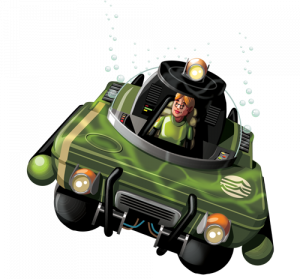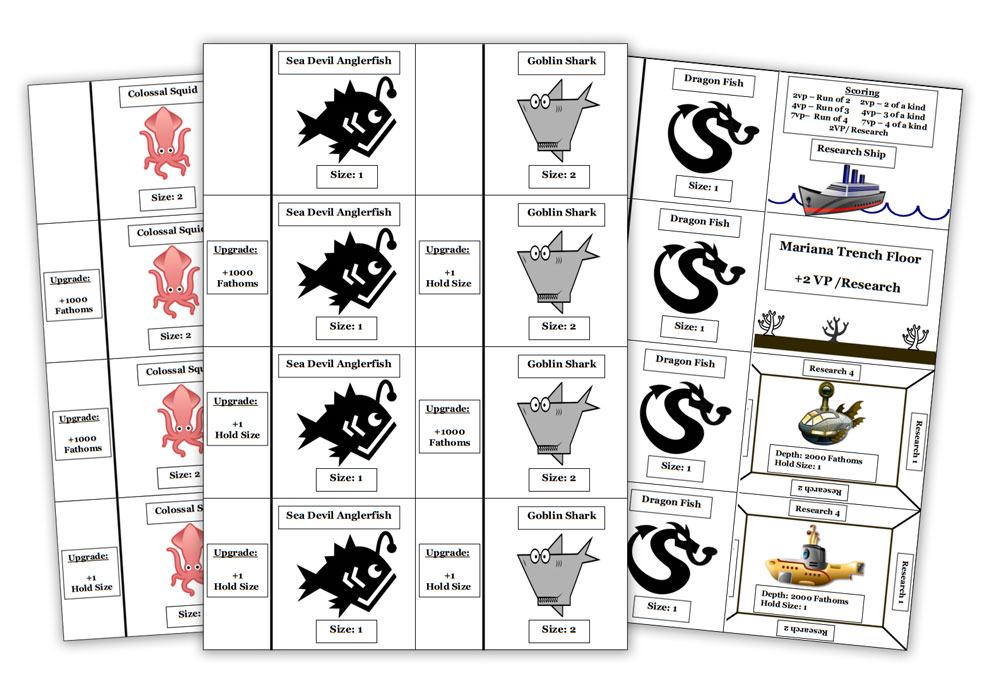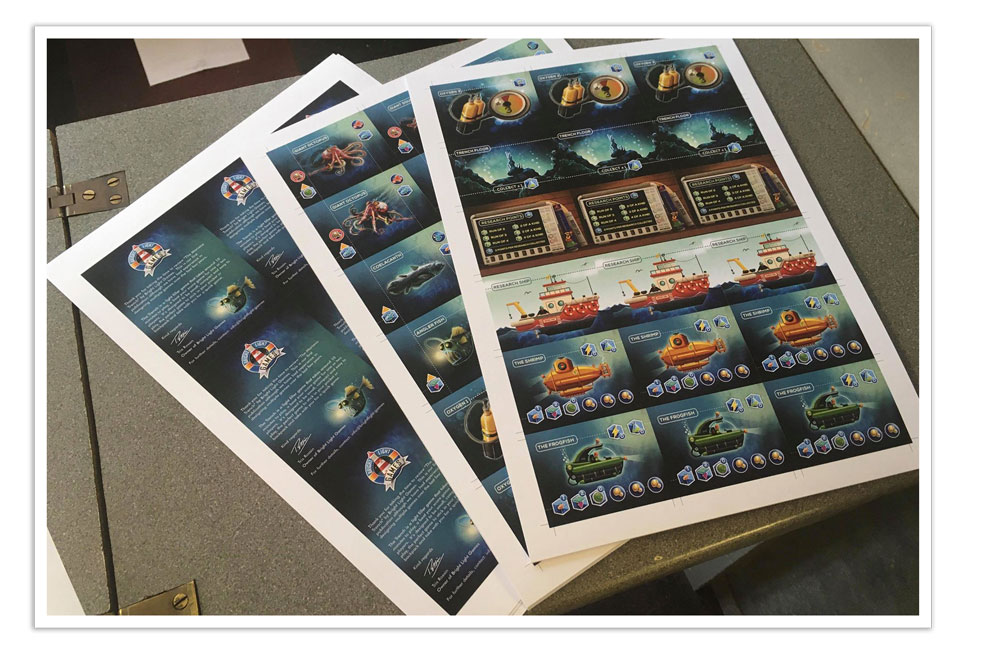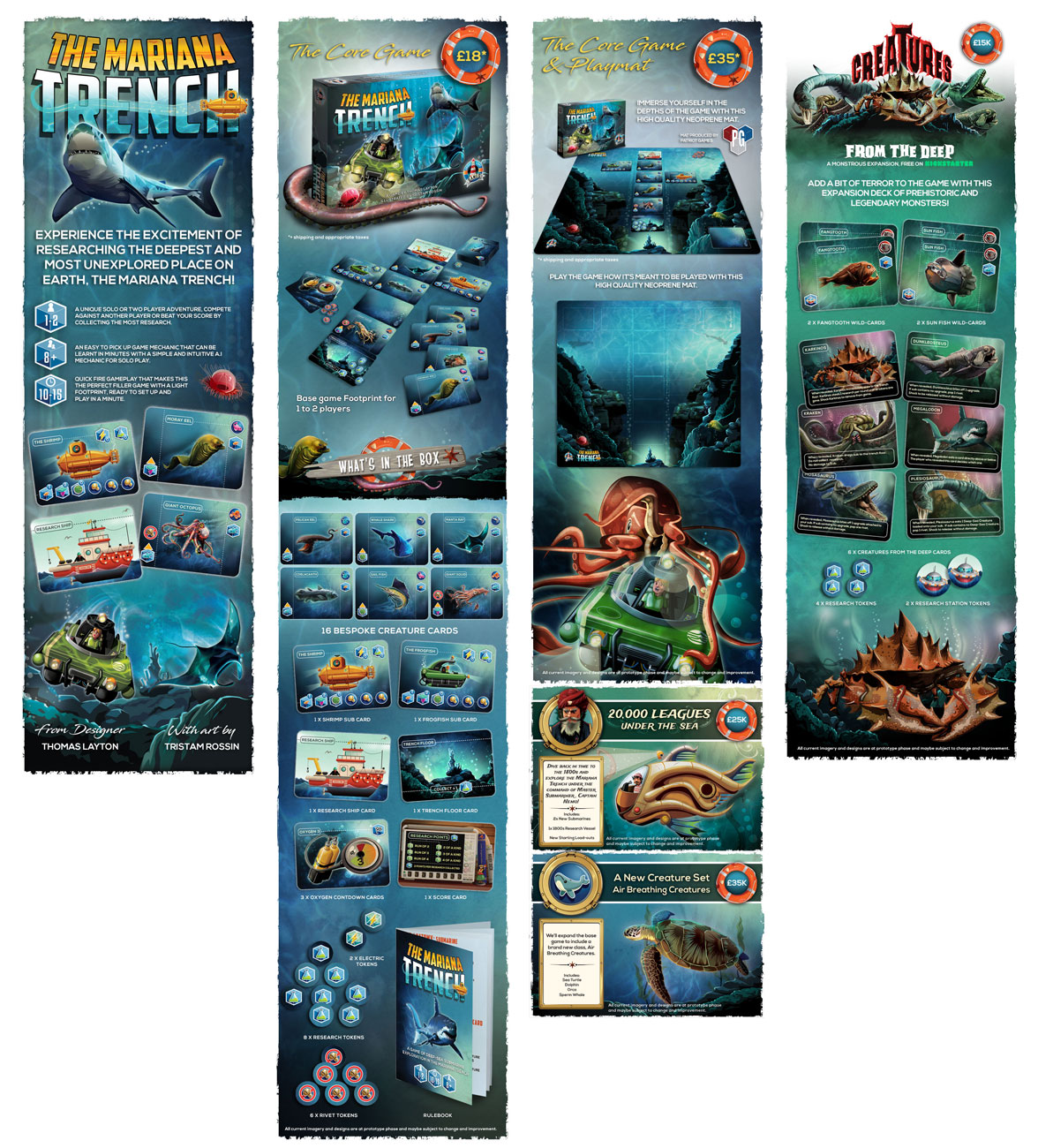How I illustrate the cards
The Mariana Trench – From Concept to Kickstarter.
So, we’re here, our project has just launched, and with that I thought it was time to reflect over the process that’s got us to this point. This is my first Kickstarter where I will be trying to publish a game. That’s not to say I’ve not had experience in this field. I’ve worked on multiple kickstarters on a graphical and marketing level before and I’ve developed the in-game art for other publishers who have successfully kickstarted their projects. But this feels different, more personal, well… it is! This time the entire weight of whether it’s successful or not lies firmly on by shoulders, I don’t mind saying with a few days to launch, I’m feeling that weight!
How it started.
January 2020. What a different time that was! Covid 19 was just about hitting the news but it felt like a tiny thing, we were oblivious to the worldwide impact it would have. I’d just had my first full-time year as a game illustrator and things where looking good. However, I realised there was a ceiling to my earnings, I’m billable by the hour and the work, while hugely enjoyable and rewarding is also high on pressure with deadlines, break-neck changes and making sure multiple projects are balancing correctly. I was ultimately feeling the burn and with a new year, new change mentality, decided that maybe the best way to deal with this was to make myself the client and design a game I wanted to publish.
The first thing I needed to do was to define what that type of game was. This was going to be my first project and I’d seen people try and fail at this so looked at the reasons why. I came up with a list of requirements that would make the process easier to manage. Firstly: The game had to be a small, low asset game. This makes it easy to produce with relatively small overheads. It also means the final product is a small package and easy to post, keeping shipping costs down too. My core skills are design, illustration, and marketing so these things were free, so the idea of a small game but with high quality art and design seemed like a winning formula.
My first port of call was the board game and design forums where I popped the question: “I’m looking to publish my first game, are there any board game designers who would like to get onboard?”
Within a week I’d had over 30 game designs emailed to me and it was time to review. This was tough! The quality was high and there were some great ideas, but I knew there was a game design out there that would really shine above the rest. That game was “The Mariana Trench”.
Thomas Layton emailed over the designs on the first day of my request, the game simply sang to me, it’s comprised of 21 cards as a base game, it’s simple to pick up and learn, plays beautifully as a solo or two player game and has real depth to it, you can learn to play in minutes but it takes a while to figure out your strategies and the best way to win. These are all winning combinations, but the idea of this being set in submarines, searching the Mariana Trench was what really worked for me. I could tell because I was designing and illustrating the game in my head as I read it for the first time and this idea was just so rich in imagery and atmosphere.
Original game concept from Tom
After signing the game with Thomas, the first thing to do is to research the idea, sourcing reference imagery and then defining what the game should look like. It’s also important for me at this point to look at the audience you wish to sell to. The game felt accessible so it needed to be child or family friendly, I wanted it to be the type of game you place in a backpack or your pocket on a day out or a game you take on holiday for a quick play in the evening.
Child friendly does not necessarily mean childish in design and sometimes it’s a good idea to go with your gut feeling. My initial idea was to be more cartoon-like in the design, but after reviewing 1000s of images about the Mariana Trench and Marine animals I quickly realised that a more mature take on the art was a stronger decision to make. This was ultimately based on a simple memory, I remembered spending hour upon hour looking at the wonderful nature books my parents had when I was a child, they were more engaging than any comic at the time, I’d lose myself for hours looking at the magnificent creatures and diversity of it all, I wanted to invoke that level of engagement again.
From draft, to vector, to post production in photoshop
Once a style of art had been defined, it was time to look at the graphic design. The creature cards in this game hold quite a bit of information. Creature name, creature type, size, and an available upgrade your sub with extras. This information must be clear and instantly readable as well as laid out in a specific manner. A decision was made to develop the card in a grid format, cards are laid on top of each other in this game to represent what’s being carried and what upgrades you have available so the need to keep things clean by allowing players to align the cards seemed an important design choice. Creature types needed to be quickly recognisable for end of game scoring and the cards themselves needed to be stacked to make that count easier to visualise. Ultimately, I think it ended up as a clean solution.
Changes Everywhere.
As with most games, there was an organic flow to the development, additions to the base game were included, for example, we added the use of rivets on a sub, these are popped by octopus and squid who attack your sub, adding a threat to the game and reducing your final score. to offset this rule, we also added the use of an electrical charge, your weapon against this attack but only available at the cost of waiting a valuable turn to recharge your sub at the research vessel.
The original graphic design was also revisited as the original icon layout was too small, we had to completely redesign to help with the legibility of the game. This and many other changes were done with the help of the board game communities on Facebook. Anyone who knows me will know I post about game design regularly. I think it is hugely important, even more-so during this period where a lot of us are locked-down. I work a very lonely job, at a desk, at home working long hours, there is no team around me to get feedback about the latest changes. The design and board game forums are my sounding board where I get advice, gauge the popularity of a project and it keeps me hard working and honest. If you are a game designer, publisher, or artist, I highly recommend you engage frequently with the communities out there. There is a wealth of knowledge, people willing to help who will also pull no punches. The best way to test your game is to throw it to the wolves and get the right feedback. In summary, don’t live in a cocoon thinking your game is great, put it out there, people will hear about it, get to know the game and you ultimately end up with a better game and also a following because of it.
I have been hugely fortunate with play testing on this game. Thomas Layton, the designer has stepped in and stress tested the game to its limits with his group of play-testers and whilst I’ve been testing vigorously too, the extra help from Thomas which has been above and beyond allowed me to concentrate more on the other aspects of the game. With the reviews now coming out and looking hugely positive, I can comfortably say that Thomas has done an amazing job designing the game and implementing new mechanics in a cohesive and balanced way.
Prototypes, Play-testing, Reviews, and Marketing.
So, we now have a working game that’s starting to look the business, it’s time to see what the wider world think. This part was new to me as I’ve historically been involved with all the design before this point and passed things over to a publisher to deal with this part. Any pre-conceptions about the art and design being the biggest part of the work quickly disappeared. There is a huge amount of marketing to develop, people to speak to and marketing opportunities to line up in the lead up to a launch.
Firstly, we got the prototypes developed, we went with a local UK firm called Butler Print & Design. We chose Robb and his company because he worked on another game I was involved with, Tranquillity and knew he delivered retail quality prototypes and boy did he deliver. The prototypes are stunning!
Hot off the press, prototype print run before cutting
The next job is to engage a wide breadth of reviewers. I wanted a couple of high-end reviews and I’d budgeted for that, but I wanted to scatter shot the review community and send out a few to newer reviewers. I also wanted to split this between video reviews and blogs to get a nice balance.
I knew there would be a relatively long lead time between sending out reviews and receiving them back, so it was now time to develop the Kickstarter page. This for me, is by far the most important part of the project. It’s your front window where you sell your game to the world. Firstly, I drafted out a script for the video and got in touch with a few video producers. The portfolios I reviewed where outstanding and the cost to get one produced reflected that. I had to decide, should I develop my own video, saving over a thousand pounds in the process and invest that money into social marketing? It was a gamble for sure. Kickstarter videos can make or break a project but at this point, I had some spare time and thought I would give it a try. I’ve worked on videos historically, but it had been many years since I’d done any and I had never done anything along the lines of a promotional video for a game. I think this is the part of the project where I surprised myself the most, the final video really works, this is in part to the voice over work by Tim Tones. This was one part of the video production I wasn’t going to do myself, and I knew it had to be delivered by a real professional, it had to be a voice that evokes the drama you feel when watching a documentary narrated by David Attenborough or Morgan Freeman. I’ve seen too many Kickstarter launch videos that look great and then the Narration starts, and it sounds amateur, badly recorded and lowers the whole project quality. I think I spent roughly £70 on hiring a professional and it’s easily the best investment I’ve made on this project. Once the voice over track was edited and put in place, the whole thing came together. Ultimately the success of the video is down to tenacity over skill. I may not be an expert, but I know what looks right and with probably too much time spent on this part I think I finally ended up with a solid marketing video.
For the Kickstarter page design, the foundation must be research, research, and research. I looked at similar games across Kickstarter and conducted my own reviews. For me it was just as important to check out the games that have done poorly as well as the successful ones. Glean the best practices and implement them into your page.
The final part to get in place is shipping and fulfilment. I’m currently in talks with a couple of fulfilment companies and the figures are roughly the same. Figuring out shipping cost is tough right now, there’s soon to be a Covid tax added to deliveries and there’s the UK leaving the EU which makes estimating taxes an interesting game, nobody knows exactly how this will impact exporting games. However, … We’ve made a financial decision to mitigate some of that impact to our customers, should The Mariana Trench be successful. We would ultimately like to make a great game, but also one that’s accessible financially too.
Only time will tell, at the point of writing this I’ve five days to go until launch. Now I can only cross my fingers and hope I survive the sleepless nights in the interim. I’ve done the best I can, and I’ve learnt a huge amount along the way, roll on Monday and let’s see what happens.
The Mariana Trench is Launching on the 26th October 2020.
If you’d like to find out a little more and see some of the reviews before launch.
To get notified of launch.
Core asset designs for the Kickstarter page









